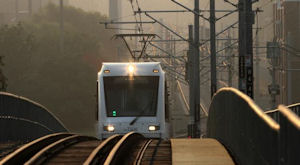by James A. Bacon
Philip Shucet, savior of the runaway train project that was Norfolk Light Rail, has submitted a proposal to to extend the rail line into Virginia Beach. Under the proposal, the Tide rail service would become operational in the Virginia Beach Town Center, nearly halfway to the Oceanfront, by November 2016 — at least four years earlier than under current projections. Moreover, the project would require no federal funding.
Shucet took over as CEO of the Tide after gross mismanagement during its construction phase, staunching losses and launching the project to great acclaim. He resigned a year ago to pursue private business interests. In his latest incarnation, he heads a group that includes Skanska, Truland Transportation, Jacobs engineering and AECOM, all of which were involved with the original Tide project.
City staff will review the proposal and report back to City Council, reports the Virginian-Pilot. Neither Shucet nor city officials revealed details of how the group planned to carry out the plan. However, Shucet has built up an impressive track record for bringing in projects on time and on budget, beginning with his tenure under Governor Mark Warner as chief of the Virginia Department of Transportation, again as a key player in the Jordan Bridge project in Chesapeake, and again as CEO of the Tide.
A consultant has produced a preliminary estimate of $807 million to extend light rail to the Oceanfront, or $254 million to stop the line at Town Center. The cost for the 12.1-mile route includes the construction of five bridges, the Pilot reports. The route would follow an existing rail bed.
Bacon’s bottom line: I am eager to see the project details. To date, Virginia Beach officials have assumed that it would be impossible to finance the project without federal participation. The Federal Transit Administration pays up to 80% of the capital costs of light rail projects. However, the regulations, red tape and a lengthy approval process can add years to the time-line and millions of dollars to the cost. By foregoing federal funding, the private group could accelerate the schedule and slash costs dramatically.
Who, then, would pay? Private investors could try issuing bonds but it’s hard to see how they would generate enough revenue from rail operations to pay back the interest and principal — light rail typically operates at a loss and requires ongoing subsidies from state and local government.
It’s possible that Shucet is banking upon state participation in the project, which is feasible given the likelihood that transportation tax restructuring will be enacted this year. The tax package devotes considerably more money to mass transit, and the McDonnell administration is very comfortable negotiating public-private partnerships.
There is one other theoretical possibility, although I have seen no indication that Shucet intends to pursue it. The ideal way to finance rail projects is through “value capture” — capturing a portion of the increased real estate values created by the transportation improvement. For example, Virginia Beach Town Center has been reinventing itself as the city’s center for walkable urbanism — compact, higher-density development, mixed uses, and pedestrian-friendly street design. Building a rail stop there on an line anchored by downtown Norfolk at one end and the Virginia Beach Oceanfront on the other would create a windfall for property owners.
A value-capture approach would create a special tax district around the rail stop, generating revenue to support, say, $50 million to $100 million in bonds. In theory, the higher taxes would be more than offset by higher leases and rents collected by property owners. Virginia Beach could sweeten the pot, as needed, by granting higher density rights to property owners in the tax district. Constructed properly, such an approach could be a win-win situation for property owners, taxpayers and commuters.
Bacon’s fantasy scenario: By eliminating federal red tape, I fantasize, Shucet has figured out a way to bring down the cost of the $800 million project to $600 million or less. The rail line, which has 10 stops in Norfolk, adds 10 more in Virginia Beach. Virginia Beach City Council establishes appropriate zoning around the 10 stops, transforming whatever is there now into transit-oriented development. The city establishes special tax districts at each stop, generating dedicated tax revenues to support bond payments equivalent to $60 million per stop. (The stops at Town Center and the Oceanfront could support more while the other, less-developed stops would support less.) Voila, 100% of the capital cost is covered by the public-private partnership!
How likely is such a scenario? Not very. Even if the numbers worked out, there is zero chance that the financing and zoning, not to mention the politics, behind such a strategy could be put into place in time for Shucet’s group to then complete design and construction by 2016.
But, hey, it doesn’t hurt to dream.



